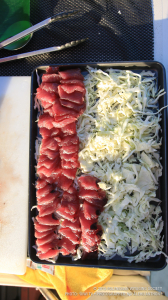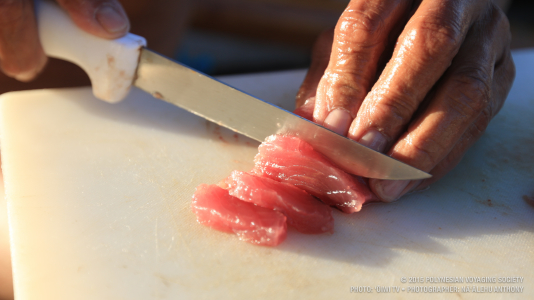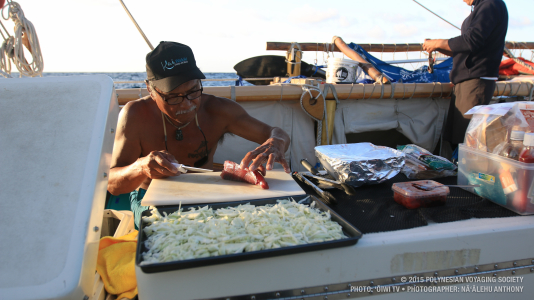
Hōkūleʻa Update | August 18, 2015
- Posted on 18 Aug 2015
- In Education, Newsletter, Teachers, Updates
 Written by Naʻalehu Anthony.
Written by Naʻalehu Anthony.AM Report
It’s colder at night than I would have thought. In contrast, the days are really hot at about nine degrees south latitude. We’re making our way more west than south, so we have many more days of this weather ahead.

Apprentice navigator Tomo checking the height of the morning sun.
Currently it’s about mid-day and Gary is just setting down his omelet station for the day. He awoke around 6 a.m. and started preparing for omelets with Patagonia Provisions bagged salmon, dried veggies, onions, tomatoes and fresh eggs. He could have made a bunch of eggs and thrown some ingredients in the pan, and the crew would have been happy. Instead he made 11 individual omelets for each crew member, served hot when you were ready. The entire process took many hours, where his every movement was intentional and measured at every step. This is not easy. First of all, he only has two burners and he’s making coffee and tea to go with the eggs. Second, winds are blowing 20 knots across his kitchen. Third, the kitchen floor is swaying from side to side as he’s trying to cut, whisk, and cook. Finally, he has to sit on a bucket while cooking as his stove is on the deck of the canoe. All of this would lend for the crew to be forgiving of the meal’s aesthetics. But none of these factors prevent Gary from making the whole process maiau a maʻemaʻe. Clean as you go, the professionals say, and this is the only way this works as anything else will leave you with a deck awash with sticky eggs and cut tomatoes.

Gary Yuen shows off his Patagonia salmon for the morning meal – made to order omelets.
Because of our watch system, some of our crew were sleeping during the meal. Rather than cook everything and serving the meal cold, Gary held the entire process until every last crew member was fed a hot meal. Talk about commitment to excellence. Thank you Gary for the wonderful meal.

Omelet construction in progress.
We can’t wait to see what happens when you have a fish to work with. All we have to do now is catch one. Speaking of fish, we had six malolo fly onboard. Only the original rugged crew would have asked for shoyu and a rusty knife. We just threw ours back in hopes of a bigger catch. So far no nibbles, no birds, no nothing. Patience will prevail, and we will send back pics as soon as we have one on the deck.

Lei hulu to show us the way the wind is blowing
This morning’s watch was an active one. Wind kept switching, and we saw a handful of sail changes. At one point we had too much speed and ran away from the Gershon II. After hovering for a few minutes, they were back, and we were on our way again. The conditions have picked up somewhat. The wind is up and with that the swells have become more sizable. The seas are confusing, but we basically have a following dominant swell rolling through our port stern quarter, lazily picking us up and turning us upwind every so often. Did I mention it’s hot? It’s hot. We’re about half way to Christmas Island, which we will look for and sight for reference for our next stop, Cocos. We’re about 320 miles in with around 3,000 more to go. All we can hope for is more meals and weather like this.

Crewmembers Kaina and Kealoha steer Hōkūleʻa with a pretty large swell behind them.
PM Report
The deep blue hue of the water has finally arrived, kai hohonu. The hue is more familiar than the green that we have seen since departure. It’s a relatively small shift but one that is welcomed and makes us feel more at home on such a strange ocean. With the blue water came the first fish! A 17 lb. aku.

Bruce lands the first fish of the trip, a modest aku
Gary had just finished dinner, rice and corned beef and cabbage when the aku hit our rootbeer colored lure. Bruce brought the fish in on the hand line with ease. Gary and Kealoha went to work on the fish. We documented the size as well as the stomach contents for the ongoing science projects. There were two malolo in the stomach. We threw those back like the rest. Gary and Kealoha left very little of the fish to throw out.
They are preparing some fish to dry. Kealoha immediately made a bed of cabbage for the sashimi, while Gary broke the entire fish down to slabs, head and bones in just a few minutes. Sashimi and fried aku were served with dinner. There is a massive fish head simmering in a soup pot at current, and the meat for drying has been prepped and finally we will have some use for that hot, hot sun.
We’re not perfect by any means, but we do practice mālama honua as much as possible. It is a curious thing to see an avid fisherman such as Bruce pull in all the lines as soon as we had one fish on board. It was late in the day, and all we needed was one. More than enough to enjoy together as a crew and that’s it. Some would be temped to try to hit another as soon as possible, but the reality is that we would end up with more fish than we could consume, and it would go to waste. Better to wait until we need more to look for more. Imagine if that was the attitude with everything that we consumed as a people…
Mahalo nui for tuning in,
Nāʻālehu
Please help keep us sailing for future generations. All contributions make a difference for our voyage. Mahalo nui loa!




